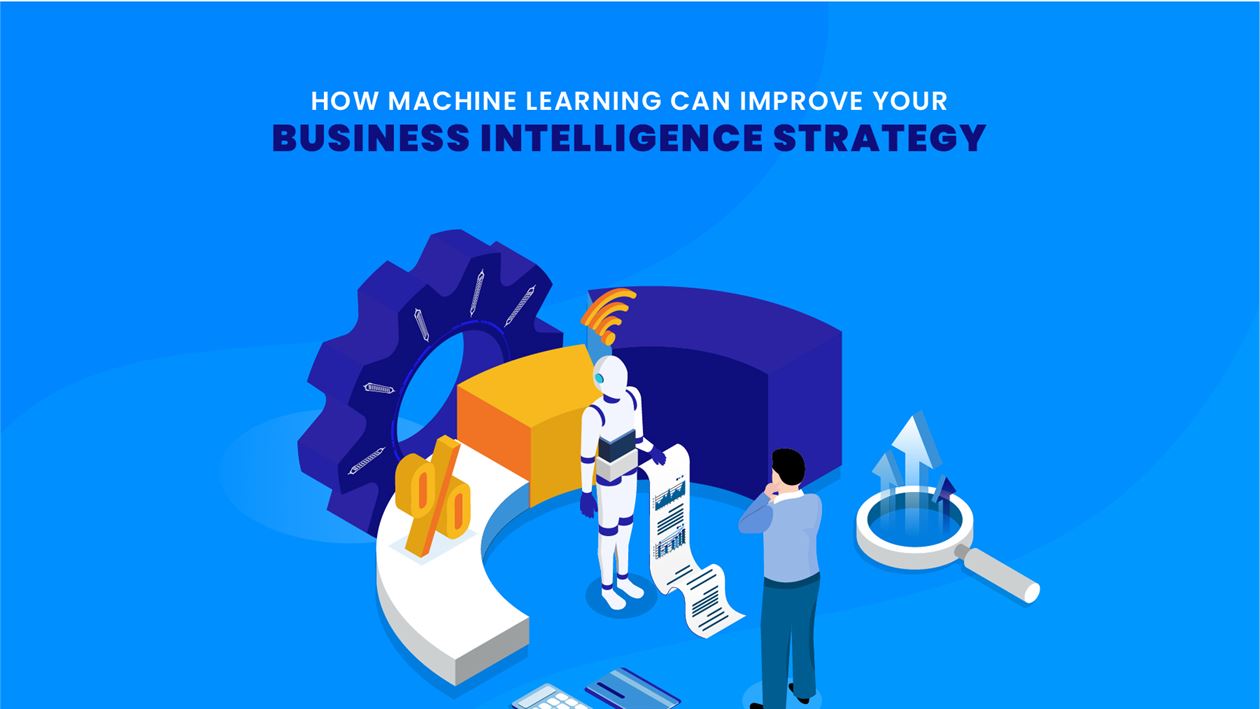In today’s fast world, businesses need data more than anything else. Data helps highlight shortcomings in business processes and also highlights the future outlook for the business. Thus it is a great asset which aids in decision making. This process is known as business intelligence and it has revolutionized data to further help businesses.
However, the way we utilize data for business intelligence is continuously changing. Gone are the days of having to maintain large blocks of registers. Instead, businesses now not only store data in machines, but also use machines to predict the future. Amazing, isn’t it? Enter the world of machine learning. So the question remains. What is machine learning and how does it help you draft strategies for business intelligence?
First, let’s understand what machine learning in business intelligence actually is, and how it’s revolutionizing the way companies conduct business.
What Is Machine Learning?
Machine learning is a subset of artificial intelligence which helps machines learn and rewire their actions by absorbing large amounts of datasets. Thus, machines are able to predict future actions by leveraging current trends. As a result, they are able to provide a better understanding about market data, financial information and other related datasets. But, that’s just the jist of it. Machine learning can be categorized into three broader spectrums, let’s look at them.
1. Supervised learning
In supervised learning, the algorithm is trained in a controlled environment. The dataset is labeled in a manner to receive a desired output. The algorithm is made to learn how to map the input data with the corresponding output variables. Common examples of supervised learning include classification and regression tasks.
2. Unsupervised learning
Unsupervized learning occurs when the algorithm is trained on an unlabeled dataset. The data isn’t linked to predetermined outcomes, and is required to build relationships itself.
3. Reinforcement learning
In reinforcement learning, the algorithm is trained in an environment, rather than a dataset. Based on the algorithm’s actions pertaining to different situations, the algorithm either receives a reward, or a punishment. In this case, the goal of the algorithm is to allow it to learn a set of actions that lead to the highest set of rewards.
Now that we know about the three types of machine learning for algorithms, let’s look at how machine learning can be a part of a company’s business intelligence strategy. So stay tuned to find out more.
But first, let’s explore the concept of business intelligence, and also highlight some of it’s limitations.
What is Business Intelligence?
Business intelligence is the use of raw data to infer actionable trends that are of use for business decision making. The goal of business intelligence is to help businesses make informed decisions by keeping in mind all the necessary factors by using the data provided to predict the future.
The practices involved in business intelligence include; data collection, data warehousing, business analytics, visualization and presentation, and providing reports about business performance.
Thus, we can see from what we have learnt above, that business intelligence is a great tool that expedites the decision making process and prompts quick action. But, let’s look at the statistics as to how effective business intelligence really is. According to the numbers from Statista, as of 2023, the market for BI tools stood at 16.39 million USD in 2023, and is expected to grow to 16.96 million in 2024. Thus, we can see an upward trend in the market, which indicates that businesses have realized the power of business intelligence, and are harnessing it’s power to improve decision making.
Although business intelligence is a comprehensive process, it also has some limitations. Let’s discuss those in the next part.
Limitations of BI
The limitations of business intelligence include:
1. Dependence on Quality Data
Perhaps the most important drawback when using business intelligence software is its reliance on real-time data. Thus, the results that BI yields depends primarily on the quality of data that you provide it with.
2. Integration Challenges
Another problem with BI is the hassle and time that is consumed while integrating and combining data. As a result, it can hamper the analytics and report marking process.
3. Scalability Problems
As the amount of data that needs to be processed grows, the software might struggle to adapt to these changes. Thus, businesses may find slower response to queries, and lags in the overall working of the software. Once again, resulting in slow decision making.
4. Implementation Cost and Maintenance Expenses
Implementing a business intelligence software has more that meets the eye, rather than just installing it. The process is comprehensive as the change has to be bought throughout the organization. Moreover, the software requires continuous maintenance to work effectively which yields and additional cost for businesses in the form of hiring professional personnel to manage the process.
Thus, although business intelligence brings along numerous advantages, it also brings along a fair deal of limitations that hamper its progress.
Now, let’s look at how machine learning can overcome the limitations brought about by business intelligence. So let’s dive in to find out.
The Combination of Machine Learning and Business Intelligence
1. Enhanced Data Processing and Analysis:
One of the primary advantages of incorporating machine learning into business intelligence is its ability to handle and analyze vast amounts of data at an unprecedented rate. Modern datasets are often too complex and extensive for traditional BI techniques to handle effectively. However, machine learning algorithms excel at identifying patterns, trends, and correlations that human analysts may overlook. By leveraging machine learning, you can gain deeper insights into your data, uncover untapped opportunities, and confidently make data-driven decisions.
For instance, imagine you’re a retail business analyzing customer purchase data. Traditional BI methods might struggle to identify subtle purchase patterns that indicate shifting consumer preferences. In contrast, machine learning algorithms can employ techniques such as clustering or association rule mining to identify these patterns. By segmenting customers based on their purchase history, demographics, and browsing behavior, machine learning algorithms can reveal distinct customer groups with similar preferences. This enables you to adapt your product offerings, marketing strategies, and pricing models to better cater to each customer segment, ultimately boosting sales and customer satisfaction.
2. Predictive Analytics for Accurate Forecasting:
Machine learning algorithms work seamlessly with predictive analytics to enable accurate forecasting, empowering businesses to anticipate future events with greater precision. By training models on historical data you can predict consumer behavior, demand patterns, revenue estimates, and more. This enables you to manage inventory more effectively, optimize production and marketing plans, and ultimately increase productivity while reducing costs. Leveraging machine learning allows you to transition from reactive to proactive approaches based on precise projections.
Consider an e-commerce business using machine learning for demand forecasting. The process typically involves several steps:
- Data Collection: Gather historical sales data, website traffic data, promotional activities, and other relevant variables.
- Data Preparation: Clean and preprocess the data, handling missing values, outliers, and inconsistencies.
- Feature Engineering: Extract relevant features from the data that might impact demand, such as seasonality, holidays, or marketing campaigns.
- Model Training: Select an appropriate machine learning algorithm, such as a time-series model or a regression model, and train it on the prepared data.
- Model Evaluation: Assess the performance of the trained model using evaluation metrics such as mean absolute error or root mean square error.
- Forecasting: Utilize the trained model to make future demand predictions based on new input data.
By accurately forecasting demand, businesses can optimize inventory levels, adjust production schedules, plan marketing campaigns, and allocate resources more effectively. This results in reduced stockouts, minimized excess inventory, and improved customer satisfaction.
3. Personalized Customer Experiences:
Customer-centricity is a key factor in the success of any business, and machine learning can significantly enhance your ability to deliver personalized experiences. By analyzing customer data such as demographics, browsing behavior, purchase history, and preferences, machine learning algorithms can generate personalized recommendations, tailored marketing campaigns, and targeted offers. This level of personalization boosts engagement, enhances customer satisfaction, and ultimately drives loyalty and revenue growth.
Let’s take the example of a streaming service provider using machine learning for content recommendations. The process typically involves the following steps:
- Data Collection: Gather user data, including viewing history, ratings, search queries, and demographic information.
- Data Preprocessing: Clean the data, handle missing values, and transforming it into a suitable format for analysis.
- Feature Extraction: Extract relevant features from the data, such as genre preferences, viewing habits, and similar user profiles.
- Model Training: Select an appropriate machine learning algorithm, such as collaborative filtering or content-based filtering, and train it on the prepared data.
- Model Evaluation: Assess the performance of the trained model using metrics such as precision, recall, or mean average precision.
- Recommendation Generation: Utilize the trained model to generate personalized content recommendations for each user based on their preferences and behaviour.
By delivering personalized recommendations, the streaming service provider can enhance the user experience, increase user engagement, and prolong user sessions. This in turn, improves user retention and drives revenue growth through increased subscriptions or ad views.
4. Fraud Detection and Risk Management:
Fraud detection and risk management are critical for organisations across various industries. Machine learning algorithms can be trained to identify trends and anomalies in data, enabling early detection of fraudulent transactions, suspicious activities, or potential security breaches. By incorporating machine learning into your BI strategy, you can enhance fraud detection capabilities, safeguard sensitive data, and protect your assets.
Let’s consider the example of a financial institution using machine learning for credit card fraud detection. The process typically involves the following steps:
- Data Collection: Gather historical transaction data, including details such as transaction amount, location, time, and customer information.
- Data Preprocessing: Clean the data, handle missing values, and normalize/scale the features.
- Feature Engineering: Extract relevant features from the data that might indicate fraudulent activity such as transaction frequency, spending patterns, or unusual transaction amounts.
- Model Training: Select an appropriate machine learning algorithm, such as a decision tree or a neural network, and train it on the prepared data.
- Model Evaluation: Assess the performance of the trained model using evaluation metrics such as accuracy, precision, recall, or F1-score.
- Real-time Monitoring: Deploy the trained model to analyze incoming transactions in real-time, flagging potentially fraudulent transactions for further investigation or triggering automated preventive measures.
- By leveraging machine learning for fraud detection, the financial institution can detect fraudulent transactions early, minimize financial losses, protect customer assets, and maintain trust and credibility among its customers.
5. Streamlined Decision-Making with Automation:
Machine learning can automate time-consuming and repetitive tasks within your business intelligence ecosystem, freeing up valuable resources and allowing your team to focus on higher-value work. Machine learning algorithms can streamline various steps in the data analysis and reporting process, including data cleaning and preprocessing, report generation, and anomaly detection. By saving time and reducing the possibility of human errors, this approach provides more reliable insights and facilitates faster decision-making processes.
For example, consider a healthcare organisation using machine learning to analyse medical records. The process might involve the following steps:
- Data Integration: Collect and integrate medical records from various sources, such as electronic health records, lab results, and medical imaging data.
- Data Cleaning and Preprocessing: Clean the data, handle missing values, remove noise, and standardize formats.
- Feature Extraction: Extract relevant features from the data, such as patient demographics, medical history, symptoms, or laboratory values.
- Model Training: Select an appropriate machine learning algorithm, such as a decision tree or a deep learning model, and train it on the prepared data.
- Model Evaluation: Assess the performance of the trained model using evaluation metrics such as accuracy, sensitivity, specificity, or area under the curve.
- Automated Analysis: Deploy the trained model to analyze new patient data, aiding in diagnosis, treatment recommendations, or disease prognosis.
By automating the analysis of medical records, the healthcare organisation can improve the accuracy and efficiency of diagnoses, facilitate personalized treatment plans, and ultimately enhance patient outcomes.
Now, time for the ending note.
Conclusion
Business intelligence is very important for businesses as it improves the decision making process. Machine learning further improves the process of business intelligence by aiding in predictive analysis to result in accurate forecasting, enhancing data processing and analytics, helping deliver personalized customer experiences, and streamlining decision making through automation. As a result, businesses can leverage real-time insights,helping them make smart investment decisions.





